Knit One, Crochet Too
A blog to accompany a podcast from folks who work at Knit One, Crochet Too, the handknitting yarn company.
Games & Hobbies 12 rész From real people who make a living playing with yarn.
0 perc
12. rész
Sometimes life gets too complicated...and we try to simplify things. This blog format got a bit out of hand last year, and it sorta went by the wayside.
I've started anew, in a simpler format in an attempt to write shorter but more frequent posts. No backlog waiting to create and edit a podcast or video. Although those are a lot of fun to make (love it), they are also very time consuming.
So here is the new version of my blog, called "My Daily Knit". Hope to see you there :)
I've started anew, in a simpler format in an attempt to write shorter but more frequent posts. No backlog waiting to create and edit a podcast or video. Although those are a lot of fun to make (love it), they are also very time consuming.
So here is the new version of my blog, called "My Daily Knit". Hope to see you there :)
Episode 10: Win Free Yarn!
0 perc
11. rész
 |
In this podcast episode:
1) We share our latest projects, including a scarf I designed that was inspired by a fabric scarf.
2) Learn how yarn prices can at times differ so much from one store to the next.
3) Check out 2 more How-To Videos: picking up a dropped stitch, and using duplicate stitching to embellish your knitwear.
4) And a free scarf pattern!
If you thought spending most work days with me would be quite enough, think again! Joyce apparently never gets enough of moi, and even dragged her husbeast to join in the fun. Eight of us spent last weekend communing with nature (and I really mean that, as in no electricity and well appointed outhouses!). The place is very picturesque, and fall colors were in full bloom. Of course, we did get some knitting in, too.
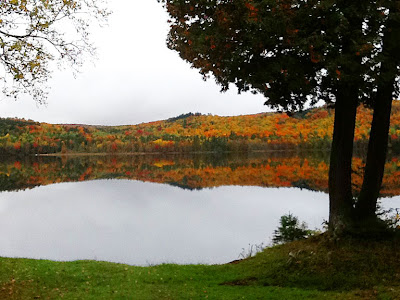
Joyce, who is always on a quest for new yarns, news fleeces, and new knitting gadgets, will be once again doing her yearly pilgrimage to the NYS Sheep & Wool Festival in Rhinebeck, NY. Dates are: October 15 and 16. Get more info here. She describes the experience as a walking fashion show, where fondling each others' sweaters is totally acceptable, and often encouraged. One of these days I'll get to go...so I, too, can do some fondling...and watch the sheep dog competition :-)
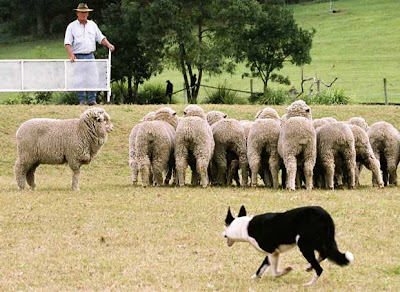
On a more serious note, Joyce and I conversed about why similar yarns are often priced very differently. And there are many reasons: Is one retailer a HUGE company that buys directly from the factory and bypasses a distributor (like Knit One, Crochet Too, aka us), and the other a small, one owner operation, that offers you a large variety of yarns to select from? Are both yarns really created equal? They may look the same and share the same fiber content and yardage, but are they coming from the same factory? And how much do those factory pay their employees, do they offer benefits, etc? All of that becomes part of the pricing structure of a yarn.
When I bought the company almost 9 years ago, I was a real babe in the woods about this part of the business. Fiber content? Got it. Designing sweaters? No problem. Finding a shipment consolidator and a customs broker? SAY WHAT?!! Now, I just get the invoices and sign the checks...and try not to dwell too much on the $$$ in fees that gets tagged on to the base price of a yarn. And don't get me started on the EURO vs US dollar. Aye, aye aye... The things one will do for a yarn addiction...
Last time, we promised you some 5-minute videos (or less), so here are a couple:
1. Picking up a dropped stitch using a crochet hook:
2. Using duplicate stitching to add touches of colors to your knitting:
So, now we come to the free yarn section. Here's what you need to do. Join Ravelry, if you are not already a member, then subscribe to the Knit One, Crochet Too group. Once there, read the directions in the post titled "We're giving away a FREE Skein of Crock-O-Dye." We'll select the winner on October 17.
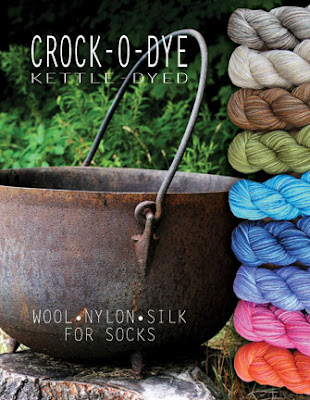 You can see some of the available colors above, and you'll get to pick the one you want. Oh, and the secret word is "Ravelry."
You can see some of the available colors above, and you'll get to pick the one you want. Oh, and the secret word is "Ravelry."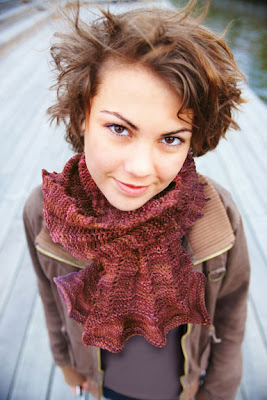 Here's the free pattern for the Picot Tricot Scarf. It features a ruffle at each end, and make-as-you-go picots on both edges. And it takes one skein of Crock-O-Dye. Fun!
Here's the free pattern for the Picot Tricot Scarf. It features a ruffle at each end, and make-as-you-go picots on both edges. And it takes one skein of Crock-O-Dye. Fun!That's all folks. Enjoy the beginning of fall and the start of a fruitful knitting season!
Hélène
Episode 9: Needle Snobbery
0 perc
10. rész
 |
|
|
In this podcast episode:
1) We discuss finishing techniques that make a difference.
2) Methods to combat biasing fabric.
3) Making your interchangeable needle tips work for you.
I like to multitask. So when the power went out last Sunday during the hurricane, I picked up my book and kept on working on my current knitting project: an upcoming design using soon-to-be-released DungarEase, a spring yarn in a soft cotton/acrylic easycare blend. Usually, if I mix knitting and reading, I stick to basic stockinette stitch. But this particular project features an eyelet basketweave stitch pattern, one that requires me to either watch what I am doing (which I can't do if I'm reading), or count my stitches as I go. So, although it was challenging, I managed to count and read at the same time. They say you should keep your mind active to keep sharp. Now, there's a knitter's exercise for the noggin!
 The swatch above shows how I inserted eyelets within the pattern, and how the ribs turn into mini lace cables. Below is the sweater in progress (back and left front). The pattern and yarn will be available in December. Cute, isn't it?
The swatch above shows how I inserted eyelets within the pattern, and how the ribs turn into mini lace cables. Below is the sweater in progress (back and left front). The pattern and yarn will be available in December. Cute, isn't it?
 You can see the button band already added to the left front. Just couldn't help myself. I had to work it out of sequence (although, really, is there a knitting law that says in what sequence to knit sweater pieces?). Since I often design as I go, I like to see NOW how things will look in the end. Even after knitting for umpteen years, I am still refining my skills: I now pick up over one whole stitch instead of over half a stitch (which I've always done up to now). It really makes a neater finish. Old dog, new trick.
You can see the button band already added to the left front. Just couldn't help myself. I had to work it out of sequence (although, really, is there a knitting law that says in what sequence to knit sweater pieces?). Since I often design as I go, I like to see NOW how things will look in the end. Even after knitting for umpteen years, I am still refining my skills: I now pick up over one whole stitch instead of over half a stitch (which I've always done up to now). It really makes a neater finish. Old dog, new trick.
In the following swatch, each section shows a new version/progression of a burgeoning idea. The swatch, changing from right to left, is explained in the podcast. Note how the lace sections at the top are biasing. After experimenting, we found a way to counteract this: Row 1: * K2 tog, yo. Row 2: Purl. Row 3: * Yo, ssk. Alternating both the slant of the decrease and the position of the yo did the trick. Another lesson to be retained for future designs, and solving pesky biasing.
 Joyce mentioned a designer who integrates biasing yarns in her beautiful knitwear: Kathryn Alexander. Check out her site. I love her use of color, and how she utilizes the 3-dimensional yarns as design elements.
Joyce mentioned a designer who integrates biasing yarns in her beautiful knitwear: Kathryn Alexander. Check out her site. I love her use of color, and how she utilizes the 3-dimensional yarns as design elements.
I find that using steam helps in slapping a biasing fabric back into place, so to speak. You can't use steam on acrylic (it will kill it dead or turn it into plastic—not a good look for knitwear), but you can use it on natural fibers. I place a wet dish towel over the knitted piece, and apply a hot iron in a "lift and press" motion. You want to hear that baby hiss!
Check out the little t-shirt below—another upcoming design for spring 2012. The yarn used is Pediwick (66% bamboo/34% nylon) which was introduced last year as a sock yarn (392 yards per 100-gr ball). With a little experimentation I discovered that this yarn can also be knitted on a size 7 needles at a gauge of 6.5 sts per inch. Knit at that gauge, this yarn drapes beautifully. A bit of slinky-ness. Me like it!
 Back in the mid-80's I co-wrote "Sweaters by Hand" (from Interweave Press) featuring a collection of designs for handspun yarns. My friend Rachael Emmons, spinner extraordinaire, spun the yarns and I designed the projects. A fun and educational process. I had never spun yarn before and I got to learn at that time.
Back in the mid-80's I co-wrote "Sweaters by Hand" (from Interweave Press) featuring a collection of designs for handspun yarns. My friend Rachael Emmons, spinner extraordinaire, spun the yarns and I designed the projects. A fun and educational process. I had never spun yarn before and I got to learn at that time.
 One of the interesting things when you design with a yarn that never existed before is discovering it's best gauge. And depending on the project, there could be more than one answer. By experimenting, you may find that some yarns in your stash can create a variety of fabric weights.
One of the interesting things when you design with a yarn that never existed before is discovering it's best gauge. And depending on the project, there could be more than one answer. By experimenting, you may find that some yarns in your stash can create a variety of fabric weights.
So next time you find yourself in a hurricane, with extra knitting time on your hands, grab yarn and assorted needle sizes, and start experimenting :-)
The tip of the week (instead of an actual mini lesson) is this: when using circular needles with interchangeable tips, use the correct size tip on your right-hand needle (the working needle) and a smaller tip on the left-hand needle. Your stitches will slide smoothly into position ready to be knitted, and there will be no more fighting to get them over the point where the cord attaches to the needle.
Hélène
Episode 8: Moth be Gone!
0 perc
9. rész
 |
|
|
In this podcast episode:
1) our mini lesson is about moth repelling/preventing tips
2) sneak preview of a new yarn: DungarEase
3) should we shorten the blog and podcast more often? You can weigh in...
As the weather starts to change with the end of summer, Joyce and I discuss taking out our fall sweaters and what methods we used to protect them from moth damage. This spurs me to go on a hunt on the net to find more information about homemade moth repellents. This actually is the mini lesson we discuss on the podcast. Note that we recorded this section outside on a windy day, so you hear a bit of ambient noise (car alarm, for example) and air blowing on the microphone (lesson learn there).
Here are some online sites with more info:
How To Get Rid of Moths With Natural Repellents
Non-Toxic Moth Ball Alternatives
How to Make Your Own Sweet-Smelling Moth Repellent Using an Orange
You can find cedar paper on Amazon.
 We share our frustration at not having local access to good button sources. Finding buttons in our neck of the woods is difficult, and online sources don't exactly fit the bill when you want instant gratification. Are you lucky enough to have a great button store in your area, or an online source that shows colors very accurately and provide speedy service to us, "I want it now" people? Feel like sharing that info? Post a comment, or email us at info@knitonecrochettoo.com
We share our frustration at not having local access to good button sources. Finding buttons in our neck of the woods is difficult, and online sources don't exactly fit the bill when you want instant gratification. Are you lucky enough to have a great button store in your area, or an online source that shows colors very accurately and provide speedy service to us, "I want it now" people? Feel like sharing that info? Post a comment, or email us at info@knitonecrochettoo.com
Here's a preview of one of our upcoming new spring yarns, DungarEase (60% cotton/40% acrylic). This child's pattern, shown in size 1 sans buttons (don't get me started), will be offered in sizes 1, 2, 4, 6, 8 and 10.
And as promised, we've uploaded a free pattern on our website, the Stained Glass Cardigan.
 As I was designing on the fly (no swatches for me, so sirree Bob) I made the stitches travel after the corrugated ribbing was done and found myself creating a stained glass window type stitch that really worked well to showcase the colors of Geologee. Sometimes you take short cuts, and you get lucky.
As I was designing on the fly (no swatches for me, so sirree Bob) I made the stitches travel after the corrugated ribbing was done and found myself creating a stained glass window type stitch that really worked well to showcase the colors of Geologee. Sometimes you take short cuts, and you get lucky.
One of the reasons (among others) that the podcast doesn't get done more often is because of this blog. As you can see, I am looooonnnng winded. So, getting the entire dog and pony show together is a many-hour process. Which explains why it doesn't happen more often. So, at least 2 listeners have told us to shorten the blog, and broadcast more often. I know. 2 people (and we love them both). Does that mean it is the opinion of the "masses" of people listening to us? Do you want to weigh in on this? You can either post here to let us know, or on Ravelry.
So this is as far as I am going as a wordsmith today. The podcast, of course, contains way more info so please take a listen to get the full effect of our conjoined knitting banter.
Helene
Episode 7: To The Trade Show We Go
0 perc
8. rész
 |
In this podcast episode:
1) we get ready for the TNNA show
2) I cram to get 2 projects done to wear at the show
3) check out the cabling-with-no-cable-needle method video
The National Needle Arts Association is a trade organization that most people involved in making/wholesaling/retailing yarn belong to. There are many designers, teachers, and publishers who are also members. The organization hosts 2 large shows, with a couple of smaller ones, every year. We exhibit at the 2 larger shows. The June show is where we showcase our fall/winter yarns, along with any new designs and accessories.
We begin the packing process in early May, with me coming up with last minute display ideas, and with Joyce pulling her hair out and gritting her teeth to accommodate these requests --- she is in charge of making sure everything is included in our crates, and I am in charge of making sure I drive her crazy. We have the perfect relationship.
So, that is our excuses for going 6 weeks without a podcast. I really enjoy the recording process (and Joyce does too) and wish we could do it once a week, but unfortunately, it will continue to be on an as-we-can basis. Hopefully you will see it as a nice surprise, sort of like getting flowers here and there, just because :-)
Back to the trade show process. Our crates got picked up about 1 1/2 weeks before we arrived and were waiting for us in the booth space the morning of set-up. I heard of a small company that came from South America and because of an erupting volcano (how dare it) that disrupted flying, their display items only made their appearance on Saturday morning, mere hours before the show was to officially open. THAT is my recurring nightmare! I am just glad it wasn't us dealing with that. I would have surely required a few slaps from Joyce to make me snap out of it!
Here are a few photos of us setting up the booth. I took them using my iPad2 and I have to say that the on-board camera stinks the big one. See how grainy they look? And while I was taking them, they looked really nice on the screen. Not so now. So, sorry for that snafu. I think you can see the process well enough, though, from the very beginning where we started hanging our black curtains (first photo), to the finished look (last 2 photos). We had help from Jennifer who lives near Columbus and knits samples for us (beautifully), and Liz, our sales rep for Minnesota. We started at 8:30 am and were done by noon (woohoo, a record for us, thank you very much ladies). The infamous crates (much discussed on the podcast) are featured in the 2nd photo. Oh, and it's Joyce in the 3rd photo making a cameo appearance.

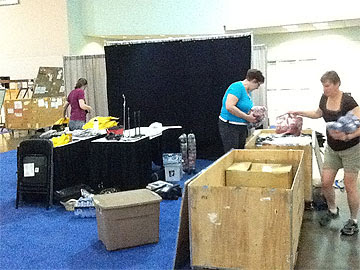


 The show went well. Those markets have been slow the last few years, but this one showed a definite upswing. Attending shows is a pricey proposition, both for exhibitors, and for buyers. The shop owners that came were there to buy. Not too many tire kickers this time around. That gave the show a nice upbeat atmosphere, and folks went home feeling recharged with optimism and inspiration.
The show went well. Those markets have been slow the last few years, but this one showed a definite upswing. Attending shows is a pricey proposition, both for exhibitors, and for buyers. The shop owners that came were there to buy. Not too many tire kickers this time around. That gave the show a nice upbeat atmosphere, and folks went home feeling recharged with optimism and inspiration.We are introducing 2 new yarns for the fall: Meadow Silk and Ty-Dy Superkid. We already have the Meadow Silk in stock (70% highland wool/30% silk), ready to ship to a store near you. The 6 accompanying patterns are being completed right now and will be available by the end of June (next week).
The yarn has a nice twist especially designed to prevent PILLING! Don't you just hate to spend $$ on a nice yarn, and hours knitting a sweater only to have the fabric pill after one or two wearings? So do we! So instead of designing a single ply yarn that looks real nice in the ball but will pill the first time you wear your sweater, we came up with this yarn. It feels a bit crispy in the hank, but it softens up nicely with steam blocking (apply a wet dishtowel to your work, and place a hot iron on the towel --- you should hear some hissing sound). It works wonders with this yarn. And that is a perfect example why you should not always judge a yarn by the feel before it's knitted and blocked. Ask your yarn shop owner if they have a blocked swatch or finished garment for you to fondle.
 See what nice twist it has? And the sheen is from the 30% silk content. The close up makes it look quite hairy, but it really isn't. It's pretty smooth, actually.
See what nice twist it has? And the sheen is from the 30% silk content. The close up makes it look quite hairy, but it really isn't. It's pretty smooth, actually. Ty-Dy Superkid is a laceweight blend of superkid mohair, wool and nylon. We selected the 7 favorite Ty-Dy Wool and Ty-Dy Socks colors and applied them to this new yarn. One ball makes the Kurly Kid Scarf.
Ty-Dy Superkid is a laceweight blend of superkid mohair, wool and nylon. We selected the 7 favorite Ty-Dy Wool and Ty-Dy Socks colors and applied them to this new yarn. One ball makes the Kurly Kid Scarf. Cute, isn't it?
Cute, isn't it? Just look at those beautiful colors...yum! This yarn will begin shipping to shops at the end of July.
Just look at those beautiful colors...yum! This yarn will begin shipping to shops at the end of July.The word for fall and winter is "Accessories." So I came up with lots of new shawl, capelet, and hat patterns. Here's a sampling of some of those:
 From left to right, the Crayon Shawlette, the Linus Capelet and Hat, and the Bowties Scarf. All of these patterns are available now (got those done at least...still have more to go!)
From left to right, the Crayon Shawlette, the Linus Capelet and Hat, and the Bowties Scarf. All of these patterns are available now (got those done at least...still have more to go!)Joyce fessed up to having an ongoing allover Alice Starmore cable sweater on the needles for 2 years! Every stitch is twisted both on the right and wrong sides, and it's been taking her one hour to work 1" of fabric. After I showed her my no-cable-needle-cable method, she says she's picked up considerable speed. And as promised in the last podcast, here's the how-to video where I demonstrate the technique:
I think it works pretty well and I doubt I'll be using a cable or double pointed needle to work my cables ever again!
Oh, and one more thing. The Knit One, Crochet Too Facebook page is up to 886 followers. If we reach 1000 people by July 4th, I will randomly select someone out of those 1000 people to win a kit of the Bowties Scarf (see above, right image)! So be sure to join and get your friends to join, too, so we can reach that milestone in time!
Hélène
Episode 6: Of Balls and Skeins
0 perc
7. rész
 |
In this podcast episode:
1) those darn pattern editing woes
2) a ball, a skein or a hank: do you know?
3) the mini lesson gives you tips on mixing and matching patterns for new design possibilities
Did I mention spring has officially arrived? So on the morning of our recording, we sat outside at the picnic table basking in the sun like a couple of seals. Well...not really...but we did record outside and we captured both the sounds of birds chirping (quaint), and sounds of a big 18-wheeler truck backing up to our door for a large yarn delivery—not so quaint but still exciting 'cause that's another thing that gets our heart racing: YARN. Ah well, it's a job, and someone's got to do it, even though this environment makes some of us salivate a bit too much (suction, please!).
One thing Knit One, Crochet Too is renowned for is our vast collection of patterns. Each season we put out around 25 new designs, offered in individual leaflets with sizes ranging from XS to 3XL. And once in a while, some of these come back to bite us where the sun don't shine...I mean, we find a mistake that totally eluded us through the editing process. Here is a typical conversation in the office: "Just got an email from a knitter saying our math is wrong on pattern (insert number)." "Oh, yeah, and is it?" "Yes, it's wrong." "What? How the heck did that happen??" "I have no idea. We've looked at it 3 ways from Sunday." "I know!! Darn it all to &^*%$$ (fill in the blank)." Very, very, very frustrating.... But we still want to know if you find something kaflooey so we can fix it.

So what is a knitter to do if you can't get a hold of us in a timely manner (over the weekend) and are stuck on one of our patterns, or if you'd really like someone to show you how to do something in the flesh? This is when you'd want to connect with other knitters for that much needed help, or just to share. A good place is through The Knitting Guild of America (TKGA). Their site lists guilds in most states. A quick Google search yielded a few links to other places to check out, including Knitting Meetup Groups, and Stitch 'n Bitch (this site lists groups worldwide). I'm not sure how up to date the listings are (I often find lots of obsolete info on the web) but it's worth checking out just to see what knitting friend (or fiend) is out there in your neck of the woods.
We caught up with our current knitting projects (are we REALLY ever caught up?) and Joyce said how she enjoyed working with Babyboo in a summer top she just finished. It's our bamboo/nylon blend, in a dk weight, and it knits to a super soft fabric. Plus it comes in many colors (not just baby colors as the name may imply).
 We have quite a few patterns that use this yarn for both babies and grown ups. By far the most popular this season is the Athena Tank, pattern 1740.
We have quite a few patterns that use this yarn for both babies and grown ups. By far the most popular this season is the Athena Tank, pattern 1740. I am working with Meadow Silk (wool/silk blend in a worsted weight), one of our new intros for the fall, that finally landed in our office last week. We have 6 projects to make by June 9, and we are scrambling to get those done in time. I've been cramming and I finally perfected a method to work cables without a cable needle -- really too lazy to bother getting my behind off the couch to get an extra needle... Isn't there a saying that goes "laziness is the mother of inventions"? No? Well, there should be... Video to come in next blog installment. Until then, just call me Smoking Needles...
I am working with Meadow Silk (wool/silk blend in a worsted weight), one of our new intros for the fall, that finally landed in our office last week. We have 6 projects to make by June 9, and we are scrambling to get those done in time. I've been cramming and I finally perfected a method to work cables without a cable needle -- really too lazy to bother getting my behind off the couch to get an extra needle... Isn't there a saying that goes "laziness is the mother of inventions"? No? Well, there should be... Video to come in next blog installment. Until then, just call me Smoking Needles...In answer to a question posed to us by farmgirlnow on Ravelry, we talked about balls, skeins and hanks. What is what, and why is what...? What?? We give our take on the difference between a ball and a skein (not 100% consensus there, so please post COMMENTS below and let us know what you think), but we did agree that a hank is a continuous large loop of yarn that needs to be wound into a ball before using. Then we explained why some yarn comes to you on hanks, and others on skeins/balls. Reasons ranging from how slippery the yarn is and how the chosen put up will try to prevent it from totally falling apart while being fondled in the shops, to selling in hanks to further convey the earthiness of a fiber or give it a more artisan feel. It's often a combination of both common sense and marketing. The samples below, from left to right, are: Paint Box, 2nd Time Cotton and Babyboo.
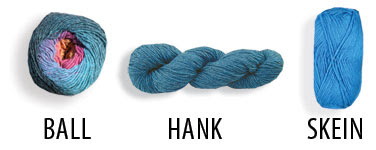
The mini lesson is about mixing and matching elements from patterns you already own. Add sleeves from one design to a sleeveless one from a different pattern in the same gauge to get just the look you want. Another tool (a blast from the past) is one of the books I wrote back in the '80s, The Knitter's Design Sourcebook. A collection of 127 charted motifs, plus a boatload of blank patterns in many gauges, sizes and neck/sleeve styles. All you have to do is insert whatever motifs in whatever configuration you want. Thousands of possibilities...and the book is out of print. BUT I am sure there are copies circulating on the web or through used book vendors, and even at your local library.

An example of an all-purpose pattern that is a good addition to your knitting library is pattern 1398, the On The Go Top. It gives directions for sizes 32" to 56", plus 3 sleeve choices (sleeveless, short and long), and is worked at 5 sts per inch. This sample is worked in Ty-Dy, 100% cotton. Use it as a blank canvas to add lace, cables, or colorwork. The sky is the limit.

And somehow, the lesson drifted briefly in the realm of gauge (as it often does) and how it's super important to work a swatch every time you begin using a new yarn, or a new pattern stitch. But if you are so disciplined that you actually can make a swatch without starting your project right away, and you want to stay organized and keep track of that darn little swatch and all the yarn info, check out our Swatch Pockets:
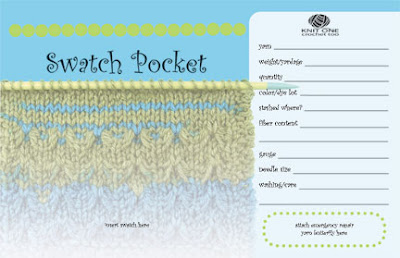 Lastly, in a total fit of masochism (it's late and I'm tired, I am still fighting off a nasty cold, or perhaps I have finally cracked), here is the photo of me from the back cover of the aforementioned book, circa mid-80s, in all my hair-raising glory (plus it looks like I was dressed ready to work at an ice cream parlor...just in case this knitwear designing thing didn't work out). There are only two good things I can say about this photo: I was young and I was thin.
Lastly, in a total fit of masochism (it's late and I'm tired, I am still fighting off a nasty cold, or perhaps I have finally cracked), here is the photo of me from the back cover of the aforementioned book, circa mid-80s, in all my hair-raising glory (plus it looks like I was dressed ready to work at an ice cream parlor...just in case this knitwear designing thing didn't work out). There are only two good things I can say about this photo: I was young and I was thin.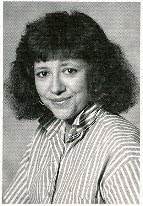
Now, please pick yourself off the floor from laughing too hard. And don't feel bad about that. I asked for it.
Hélène
Episode 5: Make the knit fit!
0 perc
6. rész
 |
In this podcast episode:
1) what makes a yarn a winner in my book
2) traveling with knitting in tow
3) the mini lesson is about choosing the right sweater to fit your body shape
I was recently asked to describe my company, and the type of yarn I sell. It got me thinking more seriously about what drives my decisions. Unlike other companies that specialize in only natural fibers, or in high end yarns, Knit One, Crochet Too has a much broader selection. Turns out I am an equal opportunity knitter! Yes, I am a knitter first, and I like a LOT of different types of yarn. When a yarn is added to our collection it means I want to knit with it. It has passed the "hand" test (how it feels and how it drapes), the feel test, the knitting test, and the inspiration test (I can see lots of design ideas)---as well as a few other tests. Of course, Joyce has input, too. I drive her crazy asking for her opinion on yarn, weight of yarn, color of yarn, what does she think of possible design ideas...all while she is trying to get her work done. What a slave driver I am...(but secretly, I think she loves it :-)
 Nautika, a new yarn for summer, is a perfect example of the type of yarn that won me over by passing all the tests with flying colors, all while being a blend of 85% microfiber acrylic and 15% nylon. Yes, I said acrylic! In the world of yarn, we know that it's a word that make some knitters turn off. Completely. But it won me over by it's softness, sheen, stitch definition, and easy care. Not to mention the price ain't bad either. And in today's world, that's a pretty good thing. Ute Grzanna, of The Knitting Basket, in Richmond, VA, also succumbed to the temptation. She first passed it over when she read about Nautika in a sales flyer we sent her. But then we did an evil thing. We sent her a small sample. Bad, bad us (insert maniacal laugh). She got hooked...and her customers did too. She said she can't keep it in stock.
Nautika, a new yarn for summer, is a perfect example of the type of yarn that won me over by passing all the tests with flying colors, all while being a blend of 85% microfiber acrylic and 15% nylon. Yes, I said acrylic! In the world of yarn, we know that it's a word that make some knitters turn off. Completely. But it won me over by it's softness, sheen, stitch definition, and easy care. Not to mention the price ain't bad either. And in today's world, that's a pretty good thing. Ute Grzanna, of The Knitting Basket, in Richmond, VA, also succumbed to the temptation. She first passed it over when she read about Nautika in a sales flyer we sent her. But then we did an evil thing. We sent her a small sample. Bad, bad us (insert maniacal laugh). She got hooked...and her customers did too. She said she can't keep it in stock.I invite you to test yourself: next time you visit a yarn shop, make your yarn selection by feel and by sight. Only then allow yourself to take a peek at the fiber content. You might be surprised by your selection.
After we got the rep packets out the door, I took a bit of a break in Branson, MO. Perfect time to go there (early April). No crowds, pretty quiet, and the weather cooperated. But of course, I never leave home without tons of yarn and needles, and I came back with this cute jacket, named Waterlily 'cause it kinda looks like the famous painting. It's made of Wrapunzel in a new color called Foxgloves (not yet shown on the website) and Ty-Dy Wool. The pattern will be available shortly as it is a late addition to the aforementioned fall/winter collection.
 I also made one sock in Ty-Dy Socks Skinny Stripes (this link shows you the original Ty-Dy Socks, minus the skinny stripes - still too new to load on the site, but shown here just to tease... :-) Oh, and the color is called Twilight. I just love that yarn---so much so, I am actually planning on knitting a 2nd sock. Matching socks, what a concept!
I also made one sock in Ty-Dy Socks Skinny Stripes (this link shows you the original Ty-Dy Socks, minus the skinny stripes - still too new to load on the site, but shown here just to tease... :-) Oh, and the color is called Twilight. I just love that yarn---so much so, I am actually planning on knitting a 2nd sock. Matching socks, what a concept!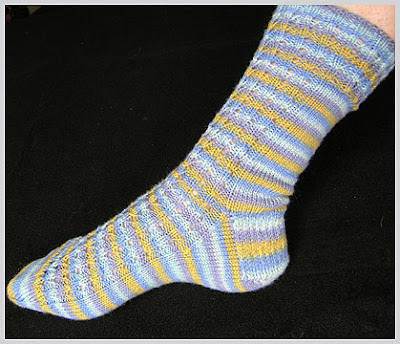 Yes, I traveled armed to the teeth with 2 pairs of straights and 2 circular needles, in my carry-on bag. No problem. But don't try that as an audience member of the Jay Leno show. You'll have to park your arsenal at the door. Yes, in January, I was a victim of the Leno Show goon squad and had to pull the needles right out of my work-in-progress. But never fear, I used my super-duper back-on-the-needle method once I got my needles back at the end of show (they were still outside in a basket when I exited). Here's a how-to video where I demonstrate:
Yes, I traveled armed to the teeth with 2 pairs of straights and 2 circular needles, in my carry-on bag. No problem. But don't try that as an audience member of the Jay Leno show. You'll have to park your arsenal at the door. Yes, in January, I was a victim of the Leno Show goon squad and had to pull the needles right out of my work-in-progress. But never fear, I used my super-duper back-on-the-needle method once I got my needles back at the end of show (they were still outside in a basket when I exited). Here's a how-to video where I demonstrate:The lesson for this episode is about identifying your body shape and selecting garments that puts your best attributes forward. Shape #1: the Pear---wider hips, narrow waist and shoulder. Best to select styles with details at the neck and shoulders, and minimal patterning at the lower edge. We suggest the Braided Yoke Tank worked in Nautika:
 Shape #2: the Apple---round body, broad chested, minimal waist definition, flat derriere, shapely legs. Select garments that divide your body vertically. The Charlie Vest in Ty-Dy can be worn with a loosely fitted belt (as shown below) that creates movement at the waist, or unbuttoned. A multi-colored garment like this will be most successful layered over a monochromatic top and pants.
Shape #2: the Apple---round body, broad chested, minimal waist definition, flat derriere, shapely legs. Select garments that divide your body vertically. The Charlie Vest in Ty-Dy can be worn with a loosely fitted belt (as shown below) that creates movement at the waist, or unbuttoned. A multi-colored garment like this will be most successful layered over a monochromatic top and pants.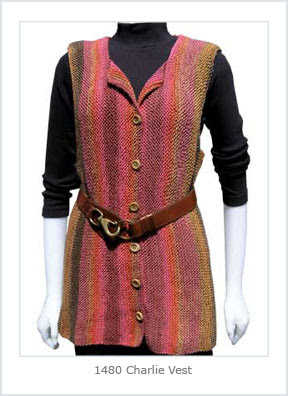 Shape #3: the Hourglass---width of hips and shoulders match with well defined waist, the perfect shape (or so I hear). The lucky hourglass can wear many styles, and is best showcased with form-fitting sweaters. The Sabrina Tee in 2nd Time Cotton molds your body for a vavavoom! effect :-)
Shape #3: the Hourglass---width of hips and shoulders match with well defined waist, the perfect shape (or so I hear). The lucky hourglass can wear many styles, and is best showcased with form-fitting sweaters. The Sabrina Tee in 2nd Time Cotton molds your body for a vavavoom! effect :-) Shape #4: the Rectangle: evenly sized from shoulder to hips, no waist definition, boyish figure. Look for waist shaping and avoid square shaped garments. The Dahlia Cardigan in Babyboo gives width to the shoulders and a fit-and-flair lower section. Lots of trompe l'oeuil action there.
Shape #4: the Rectangle: evenly sized from shoulder to hips, no waist definition, boyish figure. Look for waist shaping and avoid square shaped garments. The Dahlia Cardigan in Babyboo gives width to the shoulders and a fit-and-flair lower section. Lots of trompe l'oeuil action there. Shape #5: the Inverted Triangle---the opposite of the pear, the emphasis needs to be on the hips to balance extra wide shoulders. According to Joyce (who claims this shape as her nemesis), shapes with peplums or a flaired edging are best. The Mermaid Tee in Ty-Dy adds width to the hips, while camouflaging any tummy bulge that may have taken up residence there...
Shape #5: the Inverted Triangle---the opposite of the pear, the emphasis needs to be on the hips to balance extra wide shoulders. According to Joyce (who claims this shape as her nemesis), shapes with peplums or a flaired edging are best. The Mermaid Tee in Ty-Dy adds width to the hips, while camouflaging any tummy bulge that may have taken up residence there... Go ahead and gawk all you want at knitters modeling their creations on Ravelry.com and see what looks good on folks with a similar body type as yours. Nothing wrong with gawking. I do it all the time.
Go ahead and gawk all you want at knitters modeling their creations on Ravelry.com and see what looks good on folks with a similar body type as yours. Nothing wrong with gawking. I do it all the time.Hélène
Sometimes work gets in the way of fun...booo, hiss!
0 perc
5. rész
No podcast this week (and next week too)! For the next couple of weeks, we will be finalizing our sales rep fall/winter sample packs (a big, deadline driven project), so we won't even have a chance to record a new episode :-/
BUT, once we're done, we sure will have lots to tell you!! Don't you hate it when work gets in the way of having fun (I may still take a few minutes of yarn fondling here and there...hey, a gal's got to get her fiber fix. No cold turkey for me!)
Stay tuned...
Hélène
BUT, once we're done, we sure will have lots to tell you!! Don't you hate it when work gets in the way of having fun (I may still take a few minutes of yarn fondling here and there...hey, a gal's got to get her fiber fix. No cold turkey for me!)
Stay tuned...
Hélène
Episode 4: Vest, and socks, and shaping, too.
0 perc
4. rész
 |
In this podcast episode:
1) Joyce feels pressured by me (what?? me? nahhh...) to reconstruct her mitered vest
2) I get inspired by Cookie A., the sock mistress
4) the mini lesson is about full-fashioning
First off, let me apologize for the tapping/bumping noises on the podcast. I think as we speak, our hands move around (I am French, you know, and speak LOUDLY with my hands!), and perhaps tap the counter where the microphone sits. I haven't pinpointed the problem (we can't even think of what we were doing), and it may be annoying to hear. I'll bring my ruler next time and swat any noisy fingers! (just kidding...we'll just sit on our hands :-)
In Episode 1, Joyce and I discussed some ideas to change a vest from a too-small garment to one that fits just right. Although she claims that I "nagged" her into finally making those changes (something about being her work wife...), the finished version fits her way better, and looks great, too.
 She chose to add a solid color band, continuing in Garter stitch with a mitered stitch in the front corner. A couple of rows of the contrasting color just before the bind off brings it all together nicely. I know taking out a project you thought was done to rework it is no fun, but that is the difference between a project that sits in the closet never to see the light of day, and one you can wear proudly, and often!
She chose to add a solid color band, continuing in Garter stitch with a mitered stitch in the front corner. A couple of rows of the contrasting color just before the bind off brings it all together nicely. I know taking out a project you thought was done to rework it is no fun, but that is the difference between a project that sits in the closet never to see the light of day, and one you can wear proudly, and often!Joyce described a method of weaving a loose strand of yarn in and out of your fabric, from row to row, to use instead of a stitch marker. I searched the internet to find such a method demonstrated and didn't find anything. So I experimented and came up with this, my own version. I guess you could just as well make a small loop (like a yarn ring) and use that instead of a ring marker, but this video shows you what Joyce was talking about. Can you think of a reason to do it this way?
During my latest trip out of town (yes, again having to decide what projects to take), I took inspiration from a sock designer I very much admire, Cookie A. I find the way she makes the stitches move around in her sock designs intriguing and clever. So, as I looked at a new color of Ty-Dy Socks Dots (called Periwinkle, brand spanking new and not even in stock, yet), I decided to take a small stab at making my sock stitches travel, too. Still don't know what I'll call this design. Any suggestions?

 I recorded a short video to demonstrate the Stretchy Cast On method I used for the top of the socks. It is a new method for me so my technique is a little rough, but I think it's clear enough for you to give it a shot. It really makes a nice stretchy cast on—not too loose and sloppy looking like some other methods I've tried.
I recorded a short video to demonstrate the Stretchy Cast On method I used for the top of the socks. It is a new method for me so my technique is a little rough, but I think it's clear enough for you to give it a shot. It really makes a nice stretchy cast on—not too loose and sloppy looking like some other methods I've tried.This episode's mini lesson is about full-fashioning. As I explained in the podcast, that term refers to working your decreases a few stitches in from the edge to create a decorative ridge. The two garments shown below make good use of that technique for working a raglan sleeve. On the left, the Urbana Cardie, has the yoke worked in one piece. The cardigan on the right, the Stadium Cardie, has all pieces (fronts, back and sleeves) worked individually and sewn together. Both garments feature the feathered version of full-fashioning, and both are worked with Nautika, a high-twist and smooth yarn that shows stitch detail beautifully. It is new this season, comes in 12 coordinated colors, and is machine wash and dry (you gotta love that for a summer yarn!).
 The 2 examples below are as follows: a close-up of the Stadium Cardie with feathered full-fashioning (left), and a small swatch done in Wrapunzel with basic full-fashioning. As I mentioned in the podcast, even though this yarn has lots of personality (textures and colors), the refined detail still works well.
The 2 examples below are as follows: a close-up of the Stadium Cardie with feathered full-fashioning (left), and a small swatch done in Wrapunzel with basic full-fashioning. As I mentioned in the podcast, even though this yarn has lots of personality (textures and colors), the refined detail still works well. As I finish writing this blog entry, the sun is shining today (the process of recording, video taping, editing and writing spans several days) and I see the remnants of snow on the roof morphing into water drops. Yes, ladies and gents, spring is coming to Maine, any day now, and that makes me happy. Have a great knitting week :-)
As I finish writing this blog entry, the sun is shining today (the process of recording, video taping, editing and writing spans several days) and I see the remnants of snow on the roof morphing into water drops. Yes, ladies and gents, spring is coming to Maine, any day now, and that makes me happy. Have a great knitting week :-)Hélène
Episode 3: Business Challenges, and a bit of Lace, too!
0 perc
3. rész
 |
After a short trip to Las Vegas, I share one of my all time travel fears: running out of knitting projects to work on during a trip! From experience, I ALWAYS over pack. This time was no exception—3 projects for a 3-day trip. Really...REALLY?? Yes...I can't help it. You never know. I actually Mapquested the nearest yarn shop in advance, Gail Knits (a customer of ours), just in case...
And if you think a Vegas casino is no place for knitting, think again. While waiting for the slowest penny slot machine to pay out $111.27, I took out a sock project (note to self: never leave the hotel room without an emergency knitting project) worked in an experimental version of Ty-Dy Socks (Skinny Stripes—a new version of this popular yarn). A win/win situation ($$ + knitting in public) And by the way in case you are wondering, no tattoos!
While I was in Las Vegas for the American Rental Association trade show (Jay, my SO, owns an equipment rental store), I did not take the time to walk the show floor with him—tractors and chain saws do nothing for my creative soul. Fortunately, there is a trade organization in our industry, The National Needle Arts Association, that totally fits the bill. We exhibit our products at the bi-annual trade show, along with many other companies. The show, including classes open to members only (sorry folks, not to the general public), spans 5 to 6 days, and one of the highlight is the Friday evening fashion show. We always participate and for this latest show, we had 3 featured designs: the Mermaid Tee in Ty-Dy cotton, the Stadium Cardigan in Nautika, and the Yoga Shrug and Sock Set in Pediwick.
We have many new designs for spring, including the Athena Tank. This design is a perfect example of a blend of 2 ideas: an off-the-rack tank top with a printed motif on the racer back and a design for the Triangle Shawl from a previous season. Combine components of these 2 very different garments, and the end design is the Athena Tank (shown below in blue), pattern 1740, worked in Babyboo, a bamboo/nylon blend (very soft to the touch and machine washable).
 This pattern is also featured in the June issue of Knit'n Style magazine (should be on the newsstand any day now).
This pattern is also featured in the June issue of Knit'n Style magazine (should be on the newsstand any day now).The mini lesson for this episode is about the basics of lace: for every yarn over in lace (which creates the eyelet openings) there must be a matching decrease to offset it. If you work a yarn over without this matching decrease, the yarn over becomes an increase (and you will have more and more stitches on your needle). The following chart shows you each group of matching stitches (each color = matching stitches).
 For the groups of symbols in blue, red, purple and green, each yarn over is matched with either a k2 together or ssk decrease. The 2 orange eyelets are offset by the double decrease in between. The Hey Teach Cardigan from Knitty.com I designed in 2008 (and still going strong) is a perfect example of a pattern where you must be careful in keeping track of your matching yarn overs and decreases. In the chart below, the blue line illustrates a sample armhole shaping. The 2 circled yarn overs must NOT be worked because their matching decrease (the inverted V to the right) is no longer being worked after being eliminated by shaping.
For the groups of symbols in blue, red, purple and green, each yarn over is matched with either a k2 together or ssk decrease. The 2 orange eyelets are offset by the double decrease in between. The Hey Teach Cardigan from Knitty.com I designed in 2008 (and still going strong) is a perfect example of a pattern where you must be careful in keeping track of your matching yarn overs and decreases. In the chart below, the blue line illustrates a sample armhole shaping. The 2 circled yarn overs must NOT be worked because their matching decrease (the inverted V to the right) is no longer being worked after being eliminated by shaping.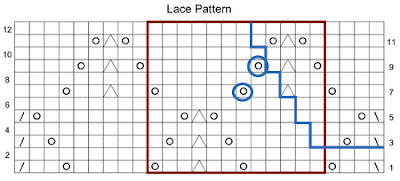 As promised, I've created a pdf file with a blank grid to be used whenever you want to chart out the complete armhole shaping of a garment, or if you want to experiment in designing your own lace—go ahead, give it a go!
As promised, I've created a pdf file with a blank grid to be used whenever you want to chart out the complete armhole shaping of a garment, or if you want to experiment in designing your own lace—go ahead, give it a go!Hélène
Episode 2: Destash and Design to Fit
0 perc
2. rész
 |
| Listen Now |
Episode 2 of the Knit One, Crochet Too podcast includes the following:
1) Weekend Wrap-Up where Joyce tells us about her major stash re-organization, and Helene discusses her week-in-knitting projects. Joyce also gets tips on salvaging a project that came out too small.
2) Do a little homework to learn how to transcribe information from garments you already own and love, onto a basic knitted t-shirt pattern.
While Joyce discussed her systematic way of purging her stash, she mentioned the McClellan's Frankenmuth Woolen Mill where she had great luck in having fleeces washed and carded. She got back beautiful balls of roving, ready to be spun.
We would both be interested to hear some of your de-stashing tips or anecdotes. Please feel free to share via comments below!
Ok, so back to the now called "Linus Capelet and Hat" set. I, not so originally, called it Linus because of the yarn it's made of (sometimes you put all your inspiration in the design and there ain't much left for the naming process, know what I mean?). Yes, I took it apart, down to the large cable band, and it really wanted to stay a capelet (minus the buttonband idea), or mini poncho, whatever you want to call it. Capelet sounds a bit like some medieval garment, and not exactly something fashionable...but it's probably just me.
 It fits about elbow length and is very warm. The hat is cute, too. This will be part of our next fall/winter season and the pattern will be available in late April. Linus is already in our line and is available now. Below is the video for the stretchy bind off shown in ribbing. You can use the same method if binding off knitwise or purlwise.
It fits about elbow length and is very warm. The hat is cute, too. This will be part of our next fall/winter season and the pattern will be available in late April. Linus is already in our line and is available now. Below is the video for the stretchy bind off shown in ribbing. You can use the same method if binding off knitwise or purlwise.The next project I managed to complete over the weekend is the Snow Flower Set worked in Petite Boucle. The yarn has too much texture to show any fancy pattern stitch and has lots of personality so it doesn't need much else. As I was unsure of its fiber content (shame on me!), I looked it up and here it is: 58% nylon/21% kid mohair/21% merino wool. The project is one size fits all adults. This will also be ready in April, and will only be available as a kit in all 12 colors of Petite Boucle . I knew I already had just the right buttons for this, and turns out I even had exactly 2 - sometimes the stars align just right.
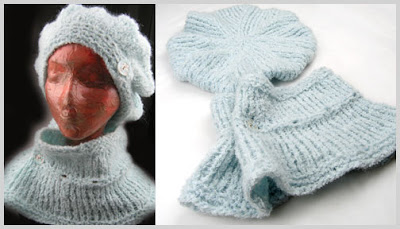 You can wear the cowl buttoned or not, depending on how much warmth you need. The button on the beret is decorative only.
You can wear the cowl buttoned or not, depending on how much warmth you need. The button on the beret is decorative only.Joyce asked for suggestions on altering a vest she made a few years ago. She's worn it a few times, even though it is a bit too small. I suggested adding a double breasted band in the center, and going around the bottom if she also wanted more length. She thought working it in corrugated ribbing (alternating k2 in blue and p2 in multi) could be another option.
 The Daisy Vest, worked in Ambrosia was designed that way because the fronts were original too small (bad me didn't bother with a gauge swatch), and I added the wider bands at the center to add to the size. The double row of buttons turned out to be a nice unplanned design element.
The Daisy Vest, worked in Ambrosia was designed that way because the fronts were original too small (bad me didn't bother with a gauge swatch), and I added the wider bands at the center to add to the size. The double row of buttons turned out to be a nice unplanned design element.
 The Daisy Vest, worked in Ambrosia was designed that way because the fronts were original too small (bad me didn't bother with a gauge swatch), and I added the wider bands at the center to add to the size. The double row of buttons turned out to be a nice unplanned design element.
The Daisy Vest, worked in Ambrosia was designed that way because the fronts were original too small (bad me didn't bother with a gauge swatch), and I added the wider bands at the center to add to the size. The double row of buttons turned out to be a nice unplanned design element. The "Made-to-Fit Tee Worksheet" is part of a "Basic Lesson Series" I decided to start. This first lesson has you try your hand at designing a basic t-shirt shaped top. I've uploaded a pdf worksheet you can download.
The "Made-to-Fit Tee Worksheet" is part of a "Basic Lesson Series" I decided to start. This first lesson has you try your hand at designing a basic t-shirt shaped top. I've uploaded a pdf worksheet you can download.Work a gauge swatch first using your stitch of choice (no, no, don't do as I do, do as I say!), then follow the directions carefully and fill in all your dimensions and stitch count first, before transfering that information on the pattern. Keep in mind that if you use a real t-shirt (made of thin knit fabric) as the garment to measure, and plan on using the pattern you create to knit yourself a tee shirt, you need to allow a bit more ease as your handknit fabric will be thicker than that of the t-shirt. Click on image below to begin downloading the worksheet file.

The Fiber Gypsy site has a great chart for Garment Ease Allowances that is worth bookmarking. I also highly recommend the book Designing Knitwear, by Deborah Newton. Although written in 1998, the information included on designing and fit, is still relevant—a must-have reference book.
 By the way, we are now listed on iTunes. Doing a search for Knit One Crochet Too should bring us up. If not, drop down the "Advanced" menu in the iTunes software, and select the "Subscribe to Podcast" option. In the input box, copy and paste: "http://feeds.feedburner.com/KnitOneCrochetToo". That worked for me. Please leave comments on iTunes as this will help in moving the podcast out of obscurity :-)
By the way, we are now listed on iTunes. Doing a search for Knit One Crochet Too should bring us up. If not, drop down the "Advanced" menu in the iTunes software, and select the "Subscribe to Podcast" option. In the input box, copy and paste: "http://feeds.feedburner.com/KnitOneCrochetToo". That worked for me. Please leave comments on iTunes as this will help in moving the podcast out of obscurity :-)This wraps up the notes portion of Episode 2. If you get stuck figuring out the t-shirt worksheet, post your questions here. Next podcast may be a continuation of this workshop. Have a great week in knitting!
Hélène
Episode 1: Taking the plunge!
0 perc
1. rész
 |
| Listen Now |
Episode 1 of the Knit One, Crochet Too podcast includes the following:
1) our Monday morning weekend wrap up where we discuss our weekend endeavors, and I report on my ongoing designs and knitting projects
2) a mini lesson on color selections, with suggestions where to look for ideas for inspiring colors
3) a short reading of a knitting related essay
Here is what the failed (so far) capelet design worked in Linus yarn looks like - before frogging.
 This is a close-up view (above) of the end where the 1" band turned into a 4" band...and still not big enough to go around the shoulders and arms, unless I place a buttonhole at the very top, and the capelet is worn open in the center. Not the look I was looking for.
This is a close-up view (above) of the end where the 1" band turned into a 4" band...and still not big enough to go around the shoulders and arms, unless I place a buttonhole at the very top, and the capelet is worn open in the center. Not the look I was looking for. This shows you the entire thing...mostly finished...with all the small braided cables...ready to be ripped back...all the way down to the large cable band (which I actually ended up doing). Next photos will be of the finished garment, done like my original idea (the one that actually fits), but in the round, with no opening or buttons. Plus, there will be a matching hat. Yes, I do like to torture myself. :-)
This shows you the entire thing...mostly finished...with all the small braided cables...ready to be ripped back...all the way down to the large cable band (which I actually ended up doing). Next photos will be of the finished garment, done like my original idea (the one that actually fits), but in the round, with no opening or buttons. Plus, there will be a matching hat. Yes, I do like to torture myself. :-)The book of designs for the roller derby crowd is called "Knockdown Knits: 30 Projects from the Roller Derby Track" by Joan of Dark a.k.a. Toni Carr. As I mentioned, you can go to Amazon.com and look inside the book to see some of the featured projects. Some cute things, some interesting things, some things a little bit weird...but what do I know, right? I am the one who went dancing in the snow bank with the referee.
 Oh, and did I mention that each sample in the book is modeled by a member of the Naptown Roller Girls? And if you are interested in our local roller derby team, Maine Roller Derby, you can read about them here.
Oh, and did I mention that each sample in the book is modeled by a member of the Naptown Roller Girls? And if you are interested in our local roller derby team, Maine Roller Derby, you can read about them here.In the 2nd section of the podcast, I give you tips on color selection. I know some knitters feel less than confident when trying to select colors for a multi-color project. I give easy tips for developing a reference list of matching color groups.
 Here is the image (above) of the Pantone color guide I use to communicate my color choices to the dye houses. From left to right, above the color chips, you can see Ty-Dy Wool, 2 upcoming colors of Wrapunzel, and the Lucia Tee, a free t-shirt pattern that uses Ty-Dy cotton.
Here is the image (above) of the Pantone color guide I use to communicate my color choices to the dye houses. From left to right, above the color chips, you can see Ty-Dy Wool, 2 upcoming colors of Wrapunzel, and the Lucia Tee, a free t-shirt pattern that uses Ty-Dy cotton. Here's a photo of the whole Lucia Tee. Isn't it cute? The pattern is written from finished size 34" to 50".
Here's a photo of the whole Lucia Tee. Isn't it cute? The pattern is written from finished size 34" to 50".I did a lot of fiddling with the podcast sound file, trying to make it sound as professional as I can. But of course, as this is our very first program, I know things can only get better. So, please forgive any popping, smacking, talking over each other, mismatch sound level, and anything else that may need working on. I do invite you to post comments of specific peeves that we will try to address. Of course, we know we won't be everyone's cup of tea...and that's ok.
We just hope to bring you some insider information from the business end of yarn, and a bit more.
Enjoy!
Hélène

